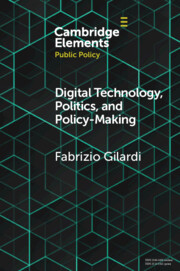Element contents
Digital Technology, Politics, and Policy-Making
Published online by Cambridge University Press: 25 May 2022
Summary
- Type
- Element
- Information
- Series: Elements in Public PolicyOnline ISBN: 9781108887304Publisher: Cambridge University PressPrint publication: 23 June 2022
References
- 18
- Cited by

